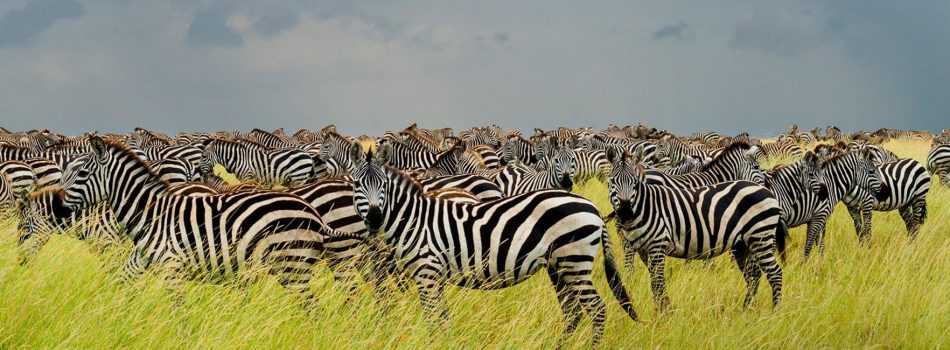
The Serengeti National Park is a Tanzanian national park in the Serengeti ecosystem in the Mara and Simiyu regions. It is famous and well known for its annual migration of over 1.5 million white-bearded (or brindled) wildebeest and 250,000 zebra and for its numerous Nile crocodile and honey badger.
The park is worldwide known for its abundance of wildlife and high biodiversity.
The migratory – and some resident – wildebeest, which number over 1.5 million individuals, constitute the largest population of big mammals that still roam the planet. They are joined in their journey through the Serengeti-Mara ecosystem by 200,000 plains zebras, 300,000 Thomson’s gazelles and Grant’s gazelle, and tens of thousands of topi and Coke’s hartebeest. Masai giraffe, waterbuck, impala, common warthog and hippopotamus are also abundant. Some rarely seen species of antelope are also present in Serengeti National Park, such as common eland, klipspringer, roan antelope, bushbuck, lesser kudu, fringe-eared oryx and dik dik.
Perhaps the most popular animals among tourists are the Big Five, which include:
Lion: the Serengeti is believed to hold the largest population of lions in Africa due in part to the abundance of prey species. More than 3,000 lions live in this ecosystem.
African leopard: these reclusive predators are commonly seen in the Seronera region but are present throughout the national park with the population at around 1,000.
African bush elephant: the herds have recovered successfully from population lows in the 1980s caused by poaching, numbering over 5,000 individuals, and are particularly numerous in the northern region of the park.
Eastern black rhinoceros: mainly found around the kopjes in the centre of the park, very few individuals remain due to rampant poaching. Individuals from the Masai Mara Reserve cross the park border and enter Serengeti from the northern section at times. There’s currently a small but stable population of 31 individuals left in the park.
Cape buffalo: the most numerous of the Big Five, with around 53,000 individuals inside the park.
Carnivores -aside from the Big Five- include the 225 cheetah – which is widely seen due to the abundance of gazelle -, about 3,500 spotted hyena, two species of jackals, African golden wolf, honey badger, striped hyena, serval, seven species of mongooses, two species of otters and the East African wild dog of 300 individuals, which recently reintroduced (locally extinct since 1991). Apart from the safari staples, primates such as yellow and olive baboons and vervet monkey, black-and-white colobus are also seen in the gallery forests of the Grumeti River.
Other mammals include aardvark, aardwolf, bat-eared fox, ground pangolin, crested porcupine, three species of hyraxes and cape hare.
Serengeti National Park has also great ornithological interest, boasting about more than 500 bird species; including Masai ostrich, secretarybird, kori bustards, helmeted guineafowls, Grey-breasted spurfowl, southern ground hornbill, crowned cranes, marabou storks, yellow-billed stork, lesser flamingo, martial eagles, lovebirds, oxpeckers, and many species of vultures.
Reptiles in Serengeti National Park include Nile crocodile, leopard tortoise, serrated hinged terrapin, rainbow agama, Nile monitor, chameleons, African python, black mamba, black-necked spitting cobra, puff adder.

